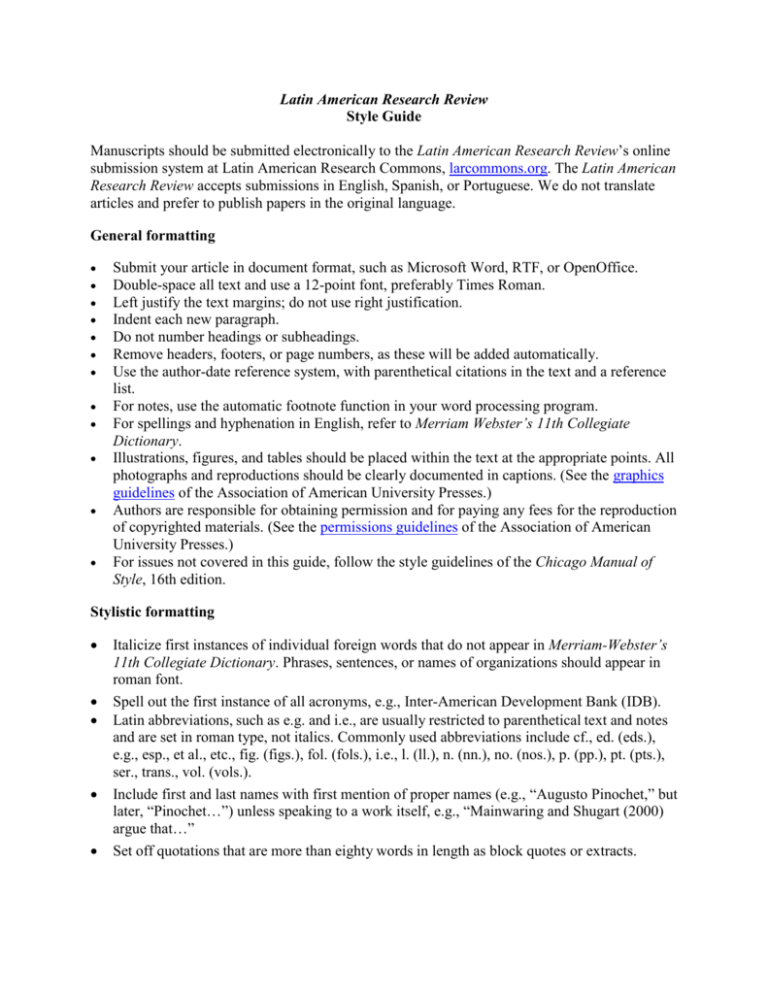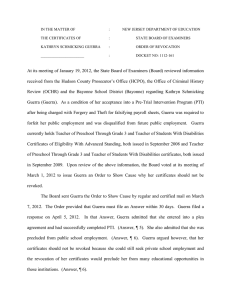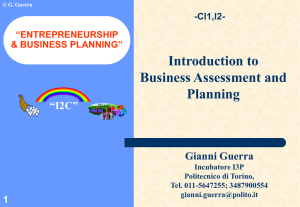Latin American Research Review
advertisement

Latin American Research Review Style Guide Manuscripts should be submitted electronically to the Latin American Research Review’s online submission system at Latin American Research Commons, larcommons.org. The Latin American Research Review accepts submissions in English, Spanish, or Portuguese. We do not translate articles and prefer to publish papers in the original language. General formatting Submit your article in document format, such as Microsoft Word, RTF, or OpenOffice. Double-space all text and use a 12-point font, preferably Times Roman. Left justify the text margins; do not use right justification. Indent each new paragraph. Do not number headings or subheadings. Remove headers, footers, or page numbers, as these will be added automatically. Use the author-date reference system, with parenthetical citations in the text and a reference list. For notes, use the automatic footnote function in your word processing program. For spellings and hyphenation in English, refer to Merriam Webster’s 11th Collegiate Dictionary. Illustrations, figures, and tables should be placed within the text at the appropriate points. All photographs and reproductions should be clearly documented in captions. (See the graphics guidelines of the Association of American University Presses.) Authors are responsible for obtaining permission and for paying any fees for the reproduction of copyrighted materials. (See the permissions guidelines of the Association of American University Presses.) For issues not covered in this guide, follow the style guidelines of the Chicago Manual of Style, 16th edition. Stylistic formatting Italicize first instances of individual foreign words that do not appear in Merriam-Webster’s 11th Collegiate Dictionary. Phrases, sentences, or names of organizations should appear in roman font. Spell out the first instance of all acronyms, e.g., Inter-American Development Bank (IDB). Latin abbreviations, such as e.g. and i.e., are usually restricted to parenthetical text and notes and are set in roman type, not italics. Commonly used abbreviations include cf., ed. (eds.), e.g., esp., et al., etc., fig. (figs.), fol. (fols.), i.e., l. (ll.), n. (nn.), no. (nos.), p. (pp.), pt. (pts.), ser., trans., vol. (vols.). Include first and last names with first mention of proper names (e.g., “Augusto Pinochet,” but later, “Pinochet…”) unless speaking to a work itself, e.g., “Mainwaring and Shugart (2000) argue that…” Set off quotations that are more than eighty words in length as block quotes or extracts. Numbers and dates Spell out cardinal and ordinal whole numbers from one to ninety‐nine (and such numbers followed by hundred and thousand), any number at the beginning of a sentence, and common fractions. Numerals are used to express very large numbers (in the millions or more). For example: no fewer than six of the eight victims no more than fifty‐two hundred gallons as many as 187 students One hundred and eighty-seven students graduated. twenty-first century attendance was about ninety thousand at least two‐thirds of the electorate there were 2 million ballots cast the population will top 25 billion Numbers that express decimal quantities, dollar amounts, and percentages are written as figures. For example: an average of 2.6 years now estimated at 1.1 billion inhabitants more than $56, or 8 percent of the petty cash a decline of $0.30 per share Dates appear in the following form: August 11, 2014; August 2014. Centuries are spelled out. Inclusive page numbers are given in full: 3–11, 74–75, 100–103, 104–109, 112–115, 414– 532, 505–516, 600–612, 1499–1500 References Use in‐text citations keyed to a reference list. In-text citations include the author’s last name (with first initial if ambiguous), year of publication, and pages referred to. For works by more than three authors, only the surname of the first author is used, followed by “et al.” A lowercase “a,” “b,” “c,” and so on is added to the year to distinguish works by the same author that appeared in the same year. “Cf.” is used when a comparison of sources is intended. Op. cit., loc. cit., infra, supra, and the like are not used. Each textual reference should correspond to a complete reference in the reference list. Entries in the reference list are arranged alphabetically by author, then chronologically, earliest to most recent. If a citation is given to an online work, an access date is required only if no publication date is provided. Please always include page numbers for journal articles, chapters, and quotations. Citations of interviews, archival sources such as manuscript collections, website content, and newspapers are usually placed in notes. For website content include as much of the following as can be determined: the title or description of the page, the author of the content (if any), the owner or sponsor of the site, and a URL. Also include a publication date or date of revision or modification; if no such date can be determined, include an access date. Sample citations and references In-text citations (Drinot 2012, 731; Degregori 1996) (Durand et al. 1996; Duquette-Rury and Bada 2013) (Rist 2007; Guerra 2010a, 2010b) (Portes, Escobar, and Arana 2008, 1058) Book Degregori, Carlos Iván, ed. 1996 Las rondas campesinas y la derrota de Sendero Luminoso. Lima: IEP. Power, Margaret 2002 Right-Wing Women in Chile: Feminine Power and the Struggle against Allende, 1964– 1973. University Park: Pennsylvania State University Press. Rappaport, Joanne, and Thom Cummins 2012 Beyond the Lettered City: Indigenous Literacies in the Andes. Durham, NC: Duke University Press. Chapter in a collection Guerra, Lillian 2010a “Beyond Paradox: Counterrevolution and the Origins of Political Culture in the Cuban Revolution, 1959–2009.” In A Century of Revolution: Insurgent and Counterinsurgent Violence during Latin America’s Long Cold War, edited by Greg Grandin and Gilbert M. Joseph, 199–235. Durham, NC: Duke University Press. Villa Rivera, William 2004 “El territorio de comunidades negras, la guerra en el Pacífico y los problemas de desarrollo.” In Panorámica afrocolombiana: Estudios sociales en el Pacífico, edited by Mauricio Pardo Rojas, Claudia Mosquera, and María Clemencia Ramírez, 331–342. Bogotá: Instituto Colombiano de Antropología e Historia. Journal article Drinot, Paulo 2012 “Creole Anti-Communism: Labor, the Peruvian Communist Party and APRA, 1930– 1934.” Hispanic American Historical Review 92 (4): 703–736. Duquette-Rury, Lauren, and Xochitl Bada 2013 “Continuity and Change in Mexican Migrant Hometown Associations: Evidence from New Survey Research.” Migraciones Internacionales 7 (1): 65–99. Durand, Jorge, William Kandel, Emilio A. Parrado, and Douglas S. Massey 1996 “International Migration and Development in Mexican Communities.” Demography 33 (2): 249–264. Guerra, Lillian 2010b “Gender Policing, Homosexuality, and the New Patriarchy of the Cuban Revolution, 1965–70.” Social History 35 (3): 268–289. Licio, Elaine C., Lucio R. Rennó, and Henrique C. O. Castro 2009 “Bolsa Família e voto na eleição presidencial de 2006: Em busca do elo perdido.” Opinião Pública 15 (1): 31–54. Portes, Alejandro, Cristina Escobar, and Renelinda Arana 2008 “Bridging the Gap: Transnational and Ethnic Organizations in the Political Incorporation of Immigrants in the United States.” Ethnic and Racial Studies 31 (6): 1056–1090. Rist, Peter 2007 “Agit-prop Cuban Style: Master Montagist Santiago Álvarez.” Offscreen 11 (3). http://offscreen.com/view/agit_prop_cuban_style. Seidman, Sarah 2012 “Tricontinental Routes of Solidarity: Stokely Carmichael in Cuba.” Journal of Transnational American Studies 4 (2). http://escholarship.org/uc/item/0wp587sj. Magazine or newspaper article Bacab Chulim, Jesús 2012 “Constatan obras del ‘3x1’: Mejorarán la casa ejidal y harán casetas policiacas.” El Diario de Yucatán, May 4. http://yucatan.com.mx/yucatan/constatan-obras-del-3-por-1. Malkin, Elisabeth, and Victoria Burnett 2015 “Cuba Frees 53 Prisoners, U.S. Says.” New York Times, January 15. Dissertation Vergara Figueroa, Aurora 2013 “Race, Gender, Class, and Land Property Rights in Colombia: A Historical Ethnography of the Afro-Colombians’ Struggles over Land, 1851–2011.” PhD dissertation, University of Massachusetts, Amherst. Paper presented at conference Gooren, Henri 2010 “The Pentecostalization of Religion and Society in Latin America: First Findings from Paraguay.” Paper presented at the meeting of the Society for the Scientific Study of Religion, Baltimore, MD, October 29.









